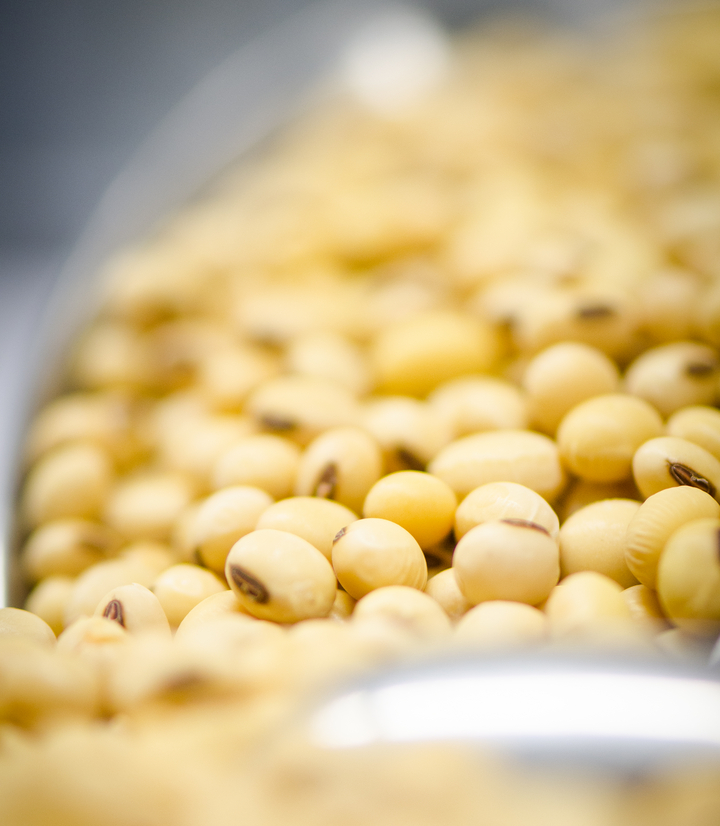Profile
Soya beans are one of the world's most important pulses. With a cultivated area of 87,500 hectares, Austria is the seventh largest soya producer in Europe.
The soya bean is becoming increasingly important as a source of protein for humans in times of a more conscious, less meat-based diet and is also an important source of protein in animal feed.
Utilisation

Soya beans have been an important food crop in China and other Asian countries for thousands of years. Nowadays, the seeds are used cooked as a vegetable (vegetable soya, green soya bean, edamame), or processed into soya milk, soya flour or tofu; they are also used as an emulsifier in the production of cooking oil, margarine, baked goods and much more.
The soya bean is also an important protein animal feed, which is mainly used in toasted, pressed or extracted form (toasted soya bean, soya press cake or soya extraction meal). These products are high-quality feedstuffs, as soya bean protein has a high biological value. To improve the digestibility and utilisation of the protein, the beans need to be heat treated, for example by toasting.
Botany
The annual plant grows up to 100 cm high with its upright stem. Most varieties have so-called determinate, i.e. limited, growth and are usually self-fertilising. However, the activity of bees and other pollinators has a positive influence; there is even pure honey.
The soya bean is actually a short-day plant, so the dark/night phase must be long enough to trigger flower formation. For this reason, harvesting was only possible very late in the year. Breeding has significantly reduced the short-day character and today's soya varieties are harvested as early as September, depending on the maturity group and climate region.
Typical of the family, the soya bean has a butterfly flower with a corolla consisting of a boat, flag and wings, the ten stamens are fused together to form a tube. The corolla is small, only slightly longer than the calyx and therefore quite inconspicuous. Their colour ranges from white to purple. Three to eight, sometimes twelve flowers are arranged together in clusters in the leaf axils.
The fruits are hairy pods up to 8 cm long and approx. 10 mm wide, usually containing two to three seeds. The round to egg-shaped seeds are smooth and yellow to brown in colour.
Agricultural aspects
The home of the parent plant, Glycine soja, also known as Glycine ussuriensis, is East Asia. Today, the main cultivation areas of the cultivated form, Glycine max, are in the USA, Brazil and Argentina.
In Austria, the area under soya bean cultivation in 2024 was around 87,412 hectares, an estimated half of which is used directly for food production. This acreage makes Austria the seventh largest soya producer in Europe.
The soya bean prefers a warm and humid climate. In Austria, it thrives best in the (south) east of the country and therefore copes well with the changing climate.
For good growth, the plants need loose, well-aerated, slightly acidic to neutral (pH value 6.5 to 7.5) soils with good water retention capacity. The water requirement is particularly high during flowering and grain formation.
Winter and summer cereals as well as grain maize are particularly suitable as previous crops. As soya beans are not very competitive due to their slow juvenile development, it is particularly important that the preceding crop suppresses late-germinating weeds and does not promote uncontrollable nitrogen release. Although the soya bean is self-compatible, it should only be cultivated every four to five years in succession due to the risk of the fungal disease Sclerotinia. The same sequence applies to other legume species such as beans, clovers, peas, etc. and other crops susceptible to sclerotinia (oilseed rape, sunflower, several vegetable species). As a nitrogen collector and a plant with a good root system for improving soil structure, the soya bean itself is a good preceding crop.
Sowing time is between mid-April and early/mid-May at a soil temperature of 10 °C. Sowing can be carried out with a seed drill or a precision drill.
The soya bean lives in symbiosis with nitrogen-fixing nodule bacteria (Rhizobium japonicum), which must be applied to the seed when the soya bean is first cultivated. They cover the plant's high nitrogen requirement. Normally, therefore, no nitrogen fertilisation is necessary; higher nitrogen doses even impair the activity of the nodule bacteria.
Finally, the time of harvest depends on the variety and weather conditions and is between mid-September and the end of October. Maturity begins with the yellowing of the leaves, which eventually dry up and fall off. The beans become round and firm and lie freely in the pod (rattle when shaken). Harvesting usually takes place a few days after leaf fall using a combine harvester, whereby the beans should have a water content of 12 to 16 %. The average yield is between 1,800 and 3,000 kg/ha.
Last updated: 15.10.2025
automatically translated